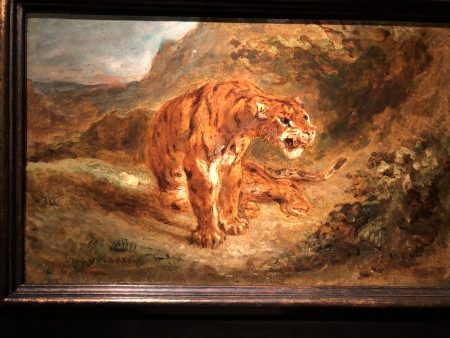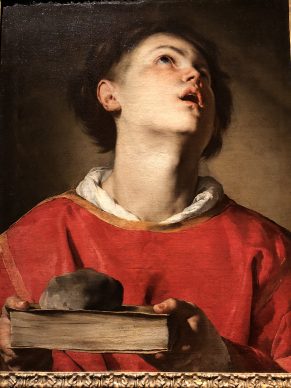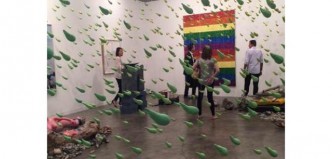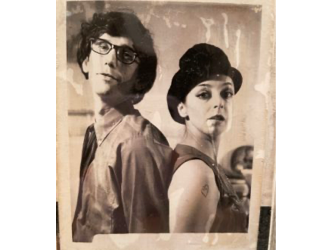280 galleries with works ranging from antiquity to contemporary art exhibit here over 10 days and this year it runs until 18 March.
Although it should be acknowledged that certain booths are a little weak when it comes to contemporary art, generally people travel to Maastricht every year from all across Europe and the United States to discover and also to buy stunning artworks.
The most hyped piece of the fair this year is a painting by Vincent Van Gogh simply depicting Lilacs. It dates from the artist’s first stay in Paris (1887).
Thickly textured with shades of pink, green and yellow, it’s an un expected piece for the Dutch artist. New York’s Hammer Gallery was asking for 9.5 million dollars for it and sold it.
The gallery is also exhibiting a painting by Eugène Delacroix (1798-1863) of one of the subjects beloved by fans of the romantic painter, a scene inspired by his trip to Morocco, “The Jewish Bride” on sale for 4.5 million dollars.
The director and president of the Hammer Gallery, Howard Shaw, explains the interest and the link between these two paintings:
Delacroix will be the subject of an important retrospective from 29 March at the Louvre followed by the New York Met, which will certainly renew interest in the artist in terms of the market.
And so at the booth of the Parisian gallery Eric Coatalem they are exhibiting a tiger painted on paper by Delacroix (on sale for 1.8 million euros). At the most highly anticipated sale of the year in May Christie’s will be auctioning the Rockefeller collection in New York, which also features a canvas depicting a tiger estimated at 5 million dollars.
In the modern range, the Dickinson Gallery of London and New York sold a stunning painting by Robert Delaunay (1885-1941) in a fauvist style, which resembles a work by Matisse. It’s an ordered explosion of colours before the artist began deconstructing forms into geometric shapes. It has been sold for around 1.2 million dollars.
The booth that seems to have had the most success this year is Colnaghi, with branches in London, Madrid and New York. No less than 19 artworks have been sold, with five days still to go before closing.
Among them was a Mater Dolorosa by the great Spanish painter Murillo (1617-1682) for around one million dollars (the Frick Collection in New York was currently showing an exhibition dedicated to him until 11 February) and a painting by Valentin de Boulogne (1591-1632), the French painter whose style is reminiscent of Caravaggio and who was the subject of a retrospective at the Met and the Louvre last year. It has been sold for 3.5 million euros. One of the two gallery owners, Nicolas Cortès, observes a rejuvenation of the clientele for Old Masters works, a discipline usually renowned for its rather more elderly public.
One of the greatest pleasures of this fair lies in the discovery of artworks that are virtually impossible to place within the “logical” flux of art history.
This is the case at the booth of the Parisian gallery of Maurizio Canesso, with a painting 3.8 metres in length that is without doubt a study for a tapestry made by the Roman known as the Cavaliere d’Arpino (1568-1640), famous for, among other things, having been Caravaggio’s first master in Rome. The painting tells the story of the ancient battle of the Emperor Constantine in shades of white and beige, with a style which almost resembles that of the modern Italian painter de Chirico (1888-1978).
It has been bought by a European collector for a little over a million euros.
Maurizio Canesso comments on the artwork:
Another uncommon painting can be found at the booth of the Swiss gallery Henze & Ketterer: a large composition by the German painter known for his expressionist style, Ernst Ludwig Kirchner (1880-1938).
His painting from 1930, “Singer at the Piano”, however, adheres to a genre closer to Picabia’s mixture of surrealism and cubism. (On sale for 3.8 million euros).
The fans of Old Masters works have talked a lot since the fair’s opening about a painting by a little-known Neapolitan artist, Bernardo Cavallino (1616-1656) depicting a young man in a strange pose holding a book, Saint Stephen in fact, sold certainly for around one million euros by the Giacometti Gallery of Rome.
The rumour, which was false, claimed that it had been sold to the Metropolitan Museum, whereas it is in fact a private American collector who made the purchase according to Giacometti gallery.
On the other hand, it is indeed this institution that made a purchase at the Georg Laue booth, a great German specialist of cabinets of curiosities of what could be the smallest objects in the fair: 5cm large.
The Metropolitan Museum bought a silver chest with gold decorations made in Nuremberg in 1627 and presented as a marriage gift by Pope Pius VII to a German nobleman in the 19th century.
Georg Laue is not at liberty to divulge the price.
But at his booth the artworks are on sale for between 10 000 and over a million euros.
Georg Laue concludes by describing the success of the fair for him this year.
Support independent news on art.
Your contribution : Make a monthly commitment to support JB Reports or a one off contribution as and when you feel like it. Choose the option that suits you best.
Need to cancel a recurring donation? Please go here.
The donation is considered to be a subscription for a fee set by the donor and for a duration also set by the donor.















